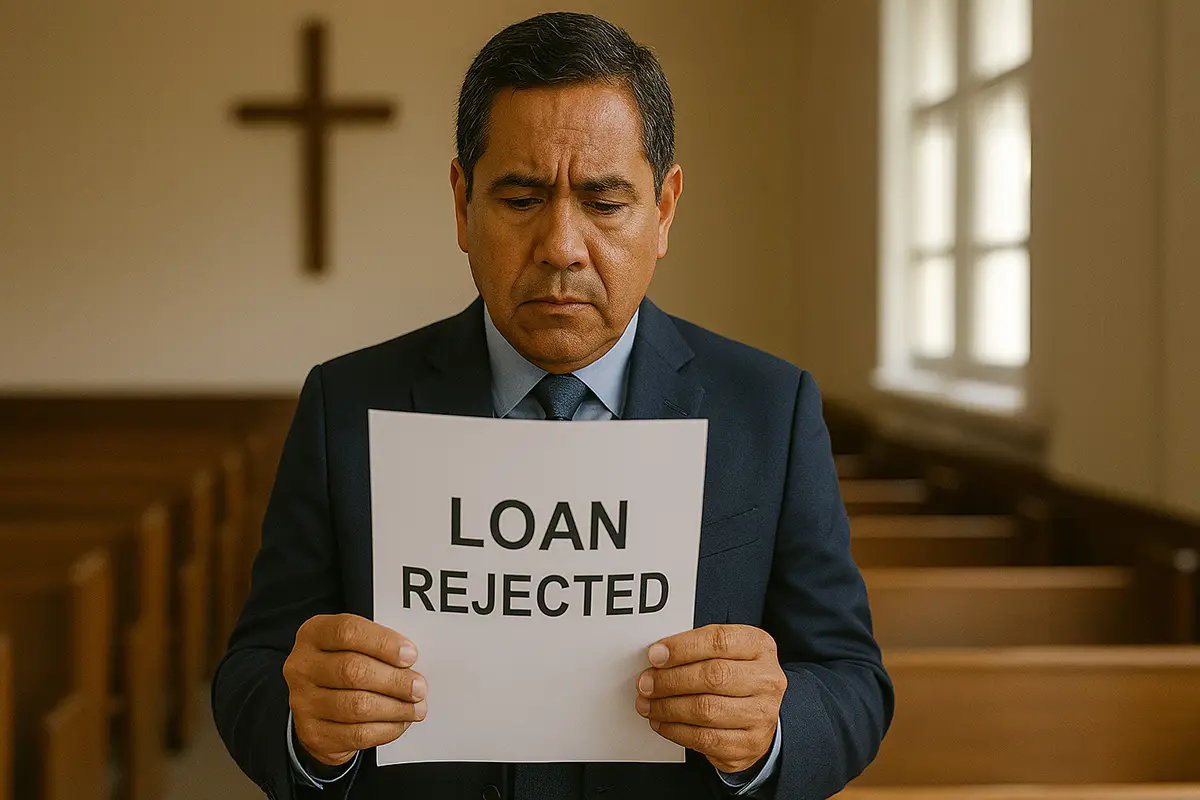For many churches, applying for a loan is a critical step toward growth—whether it’s purchasing land, building a new sanctuary, or renovating outdated facilities. But navigating the loan process can feel daunting, especially for churches that operate very differently from traditional businesses.
In this post, we’ll break down the top challenges churches face when applying for a loan—and, most importantly, how to overcome them with confidence.
Common Challenges Churches Face When Applying for a Loan
1. Lack of Traditional Financial Documentation
Unlike businesses, most churches don’t file tax returns or produce detailed profit-and-loss statements. Payroll can be minimal or handled irregularly. This absence of standard documentation can raise concerns for lenders unfamiliar with nonprofit structures.
2. Limited or No Credit History
Many churches function for years without opening lines of credit or taking on debt. While this shows fiscal responsibility, it also means there’s little to no credit history for lenders to evaluate.
3. Unclear Legal Structure or Missing 501(c)(3) Status
Some churches operate without formal incorporation or haven’t obtained federal tax-exempt status. Missing documentation or an outdated legal structure can become major roadblocks during the loan approval process.
4. Inconsistent or Seasonal Cash Flow
Giving often spikes around holidays and dips during summer months. These fluctuations can make lenders worry about a church’s ability to manage consistent monthly loan payments.
5. Difficulty Demonstrating Repayment Ability
Without traditional revenue streams, churches may struggle to show how they will reliably repay the loan—especially if they don’t have additional income sources like space rentals or fundraising programs.
6. Property Appraisal and Zoning Issues
Churches sometimes purchase unconventional or rural properties, which can be difficult to appraise accurately. Additionally, local zoning laws may not automatically permit religious use, creating complications.
7. Lack of Strategic Planning
Some loan applications are submitted without a clear plan for how funds will be used, how repayment will work, or how the project aligns with long-term church goals.
8. Choosing the Wrong Type of Lender
Not all lenders are equipped to work with faith-based organizations. Some may apply rigid commercial standards or misunderstand how churches function financially.

How to Overcome These Challenges
1. Organize and Present Financial Records
Start by creating monthly financial statements, even if your church isn’t legally required to. Track tithes, offerings, operating expenses, and cash reserves. Consider hiring a church-friendly bookkeeper or accountant to bring clarity to your records. Tools like Nonprofit Accounting Basics can be helpful resources. Start by creating monthly financial statements, even if your church isn’t legally required to. Track tithes, offerings, operating expenses, and cash reserves. Whether urgent or not, having organized financials is vital to understanding your income and expenses. Consider working with a specialist like Superior Bookkeeping, who offer quarterly services to ensure ongoing clarity and compliance.
2. Start Building Credit Early
Open a bank account in the church’s name and use it for all financial activities. Apply for a low-limit church credit card or small line of credit, and be diligent with payments. This helps establish a financial track record that will make future loans easier to obtain.
3. Clarify Legal and Tax-Exempt Status
Ensure your church is formally incorporated as a nonprofit and has a valid 501(c)(3) designation. Keep your bylaws, Articles of Incorporation, and board meeting minutes up to date. Legal resources like Nolo offer guides on nonprofit compliance.
4. Prepare for Seasonal Giving
To ease lender concerns, show several years of giving trends and explain how you manage lean seasons. If your church runs stewardship campaigns or maintains cash reserves, highlight these strategies in your loan application.
5. Create a Strong Repayment Strategy
Document how you’ll repay the loan, not just through giving but also through rentals, events, or additional fundraising. Provide detailed cash flow projections and include notes about your congregation size and growth trajectory.
6. Work with Appraisers and Zoning Experts
Before purchasing property, consult with professionals who understand church real estate. Make sure the land is zoned for religious use and the property can be accurately appraised. Some lenders will help connect you with trusted professionals during this phase. Before purchasing property, consult with professionals who understand church real estate. Make sure the land is zoned for religious use and the property can be accurately appraised. While zoning can be complex, a commercial real estate expert like Riverflow Commercial can be a valuable resource during this process. Some lenders will also help connect you with trusted professionals during this phase.
7. Build a Comprehensive Project Plan
Lenders want to see a detailed vision. Include architectural plans, timelines, contractor quotes, and fundraising goals. Involve church leadership and congregation to show commitment and unity behind the project.
8. Choose a Church-Savvy Lender
Perhaps the most important step is working with someone who truly understands the unique financing needs of churches. At Iglesias Loans, we specialize in guiding religious institutions through the loan process—and we can connect your church with the right lender, based on your specific goals and situation. Our role is to help simplify the journey and ensure you’re matched with a trusted partner who supports your mission.

FAQs
1. How much can a church borrow for a loan?
Loan amounts vary depending on the church’s financial health, credit history, and property value. Iglesias Loans offers customized solutions to meet your ministry’s specific needs—starting from $200,000 and up.
2. Can a church get a loan without a credit history?
Yes, but it may be more challenging. Churches without credit history can still qualify by showing consistent giving records, strong leadership, and a solid repayment plan.
3. What interest rates do churches typically pay?
Interest rates depend on market conditions, creditworthiness, loan type, and term length. At Iglesias Loans, we work with a large network of banks that offer competitive rates tailored to churches and religious institutions. Our goal is to help connect you with the lending partner that best fits your needs.
4. What documents are required to apply for a church loan?
While documentation may vary by lender, expect to provide:
- Financial statements (2–3 years)
- Articles of Incorporation and bylaws
- 501(c)(3) designation letter or EIN Letter from IRS
- Board resolutions
- Budget and cash flow projections
- Certificate of Filing
5. How long does it take to get approved for a church loan?
The process typically takes 30 to 90 days. Having your documents organized and a clear plan in place can help speed up approval.
Final Thoughts
Applying for a church loan doesn’t have to be overwhelming. With the right preparation and a trusted lending partner, your church can take meaningful steps toward its mission and vision.
If you’re ready to explore your church’s loan options—or just need help understanding where to start—contact Iglesias Loans today. We’re here to guide you every step of the way.


